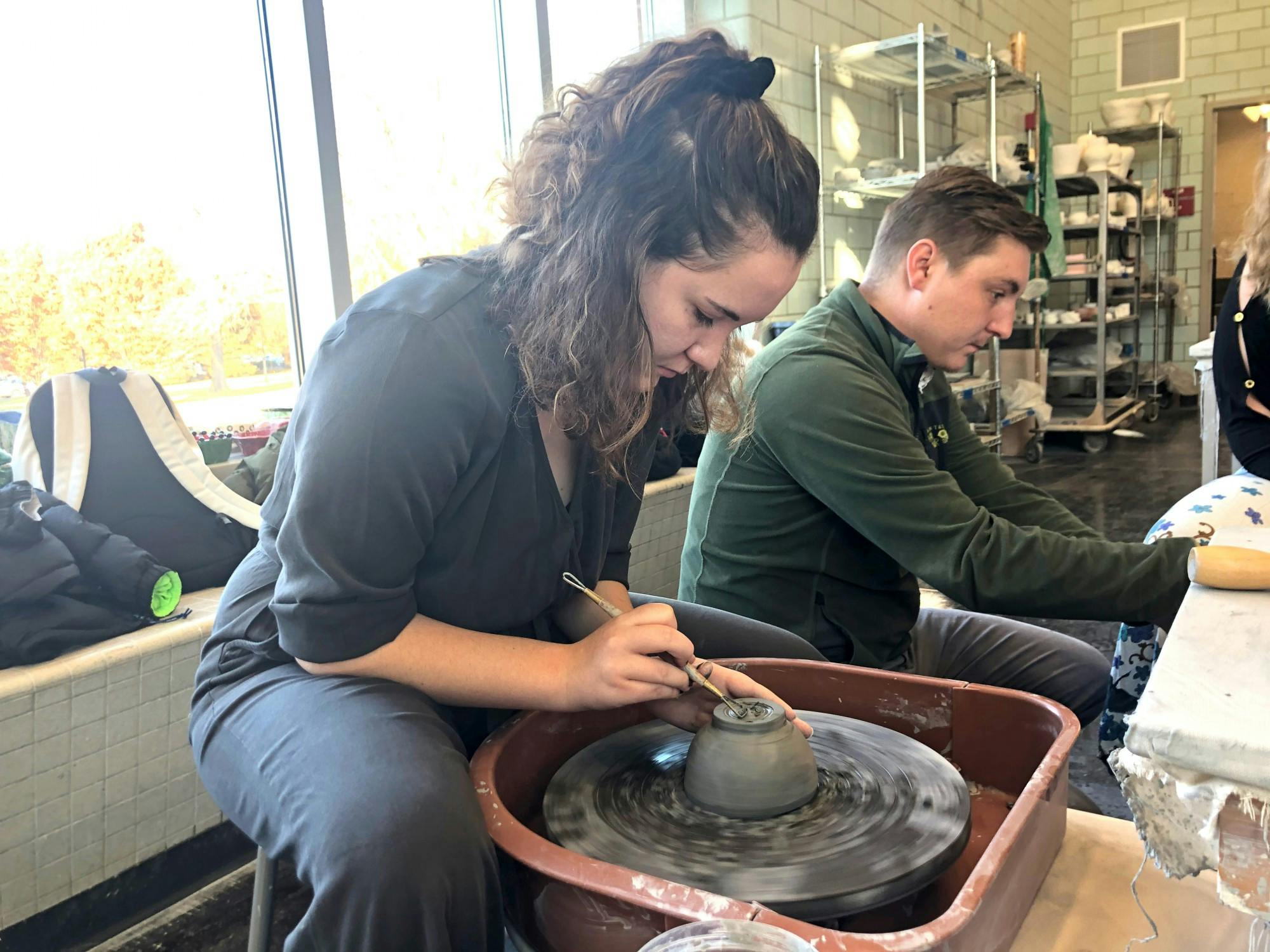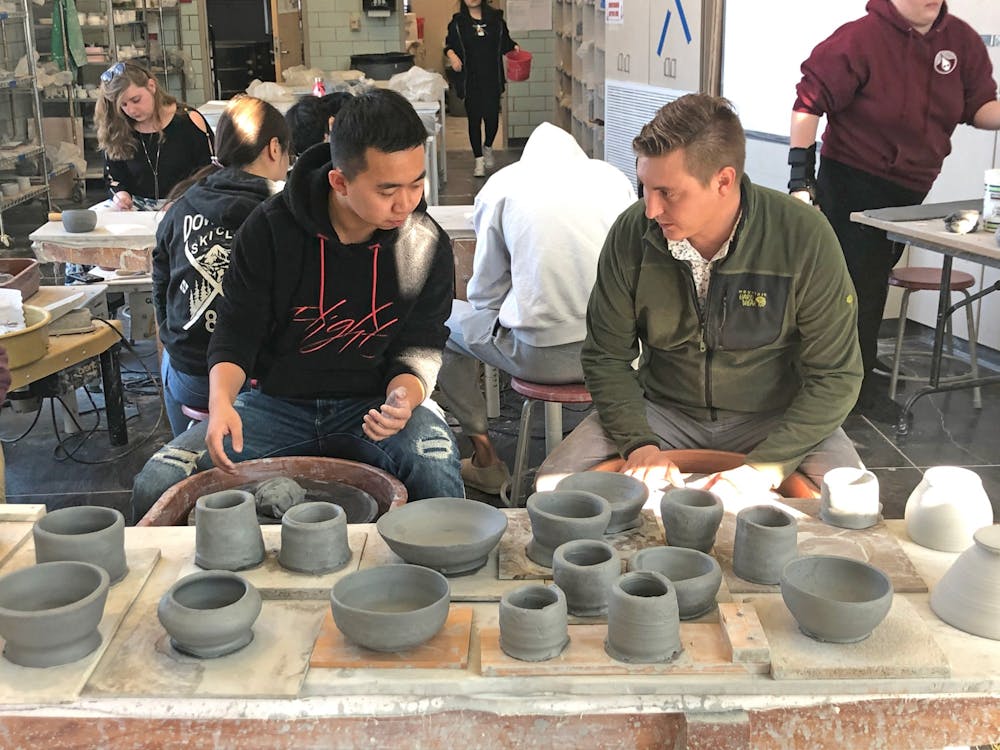The pottery wheels hum softly as nine students bend over their work, hands gently wrapped around the spinning cups and bowls. Bright sunlight blazes in from the almost-full-length windows spread across two walls of the room, illuminating the space and the students’ faces.
The professor, Neil Simak, wanders around the room with a handmade bronze-colored mug in one hand, sipping from it as the sunlight catches on the iron freckles decorating the ceramic surface. Simak sets the mug down to help a student, squatting down to the level of the wheel to point out where the student should trim the edge of their creation.
When senior diplomacy and global politics major Sarah Gaddy finishes trimming the foot of her bowl, she takes it off the wheel and brushes off the clay trimmings with a smile. The dark gray bowl sits steadily on its new base on the worktable, ready to be fired and glazed for Gaddy to take home.
All students who take ART 160: Beginning Ceramics walk away with at least six finished products at the end of the course. In just seven weeks, people with varying levels of artistic experience learn the fundamentals of ceramic-making, working with clay, water and specific tools to create their own masterpieces.
The class only meets once a week, so students are asked to spend at least three hours per week in the studio outside of class time, signing in at a small booth in Phillips 103A. This gives them a chance to fine tune their pieces or complete steps they ran out of time to do during class.
Simak said Beginning Ceramics has been offered for decades, but since he started teaching it three semesters ago, he decided to make it more approachable for students.
“The style of the course is very loose,” Simak said, “where we don’t want people to be afraid of the material — we want them to be open, feel free to ask questions, just make some cool stuff.”
For the first half of the sprint course, students dedicate almost all of their time to the first project, called a coil. This time-consuming project introduces a bit of the history of ceramics while also teaching people about the basic tools and materials used to create ceramic objects.
“Usually the coil project has some sort of historic significance, since ceramics is one of the oldest art forms,” Simak said. “So we’ll base it off of something that at least predates 1600 and usually recreate that piece or recreate the form and put in a more contemporary design or vice versa.”

After working on the coil, students will jump into the slab project. Instead of rolling out long coils and binding them together, the clay is worked through a “giant pasta maker” type machine that rolls out a slab of clay of a certain thickness. Students then shape the slab into a cup and, at Simak’s insistence, add an animal design to the cup to give it a more “whimsical” appeal.
But the task most students look forward to is the wheel-thrown project at the end of the sprint course. They have to shape and design two cups and two bowls on the pottery wheel, making sure the clay stays centered and formed as the wheel spins mercilessly under their hands.
Enjoy what you're reading?
Signup for our newsletter
Senior international studies and public health major Liz Jonas caught on quickly to the first few hand-crafted projects, but getting used to the wheel was more of a struggle than she anticipated.
“I thought the wheel was gonna be pretty chill, but I was absolutely horrible at it,” Jonas said. “So it was really interesting in terms of, like, skill growth that I had to go and watch hours of YouTube videos, of tutorials, to try to get to a point where I could have something that I wasn’t ashamed of or didn't just fall apart.”
Very few art or ceramics majors take the course, leaving it to students from other majors who need a creative course for their Miami Plan.
But several students in the class said they used to take ceramics in high school or have been thinking about taking it and never had the chance. They use the course to brush up on old skills and develop new ones, especially people who have never worked with a pottery wheel before.
Gaddy, who’s been making ceramics on and off for the past several years, appreciates how the course has opened her eyes to a different side of ceramic-making and taught her more technical procedures. Like Jonas, she initially underestimated the pottery wheel, but after putting in more and more studio time, she noticed a visible difference in her creations.
“I spent a lot of time on the wheel because I had a vision of what I wanted to do, but actually doing it was a bit trickier than I expected,” Gaddy said. “But overall, I’m pretty happy with how things turned out.”
Putting in extra time on a specific piece is exactly what Simak wants for students taking the course. Part of the new changes he implemented was cutting back on the number of projects that had to be completed so students like Gaddy will become more familiar and comfortable with the few objects that are produced.
“It’s more quality over quantity, which I feel has worked out,” Simak said. “Students get to know those pieces much better, especially with the wheel thrown pieces, because cups and bowls are intimate objects that we use everyday.”
Simak hopes that having a physical object to hold and interact with will help students appreciate art and feel more comfortable pursuing artistic interests. No matter how busy or stressed students get throughout the semester, Simak wants the pottery studio to be a relaxed atmosphere where it’s just the students and their art.
It’s always time to seize the clay.




